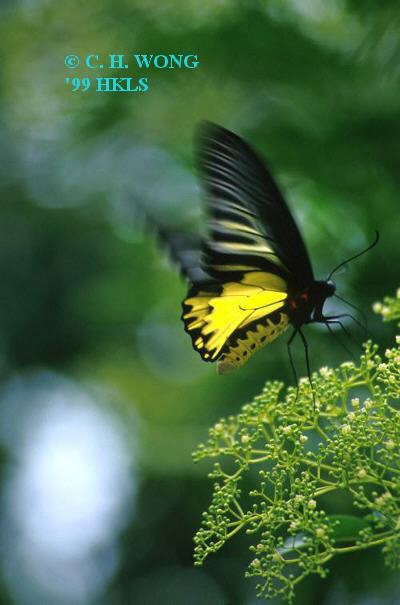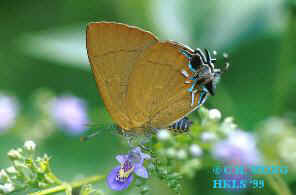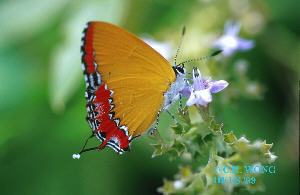Hong
Kong Lepidopterists' Society Events & Activities
Po Lin
Monastery to Tung Chung, Lantau Island
field trip on 5th Sept. 1999 for watching the
Troides species
Report and photographs by Chi Hung WONG
Organiser: James Young. Participants:
Chi-Hung
Wong, Jeffrey Yiu, James Young.
We met at about 8:30am in Tung Chung MTR station and
headed off to Po Lin Monastery by bus. On arrival, James made a close
inspection on the Salix babylonica (L.), the
host plant for Phalanta phalantha (Nymphalidae)
which was next to the car park at the Monastery. He had no luck
finding any of the immature stages of the butterfly and we then took
the path next to the tea garden for Tung Chung.
 Although we had to walk all the way from the Monastery down to Tung
Chung by the sea and part of the path was quite steep, it was not too
difficult as it was a cloudy morning. Along the path, James introduced
some host plants for butterflies especially plants of the Rutaceae
family including Zanthoxylum nitidum (Roxb.)
DC and Tetradium glabrifolium (Champ. ex.
Bentham) Hartley. The ones that you can easily identify by their strong
smell when you crush their leaves. By the way, the scenery at the Fung
Wong Shan was magnificent. The peak was partially covered by clouds and
made it even looked higher.
Although we had to walk all the way from the Monastery down to Tung
Chung by the sea and part of the path was quite steep, it was not too
difficult as it was a cloudy morning. Along the path, James introduced
some host plants for butterflies especially plants of the Rutaceae
family including Zanthoxylum nitidum (Roxb.)
DC and Tetradium glabrifolium (Champ. ex.
Bentham) Hartley. The ones that you can easily identify by their strong
smell when you crush their leaves. By the way, the scenery at the Fung
Wong Shan was magnificent. The peak was partially covered by clouds and
made it even looked higher.
After walking for a while, we saw a few Pachliopta
aristolochiae
(Papilionidae) flying slowly around us, but they were still too fast
for us to taking
photographs. We noticed the host plant of the butterfly namely Aristolochia
fordiana (Hemsl.) was everywhere along the path and James
found a few larvae
chewing away the young foliage of their host.
The morning was cool and suddenly we saw several Troides
aeacus, both male and female, flying over us. Some of
them went for the blossoming Zanthoxylum nitidum glowing
along the path.
We were over excited, especially Jeffrey and I as it was our first time
to see the wild golden birdwing! As expected, they were much more
beautiful than those we saw at the butterfly house of the Ocean Park.
We couldn't help taking many photographs on these lovely butterflies.
We were all very pleased. While we were taking shots on the
butterflies, a few people passed by and showed their sympathy for the
butterflies being photographed. We were puzzled what were on their
mind. We did not border to ask and after a while we went down further
to arrive at Shek Mun Kap where
we had our lunch.
 We saw a lot of butterflies including Papilio polytes,
Danaus genutia, Euploea midamus, Hypolimnas bolina, Junonia almana,
Lethe confusa, Athyma perius and Polyura nepenthes.
We were most impressed by two Lycaenids, namely Heliophorus
epicles and Remelana jangala.
We saw a lot of butterflies including Papilio polytes,
Danaus genutia, Euploea midamus, Hypolimnas bolina, Junonia almana,
Lethe confusa, Athyma perius and Polyura nepenthes.
We were most impressed by two Lycaenids, namely Heliophorus
epicles and Remelana jangala.
 It was our (Jeffrey & I) first time to see them. They showed very
unusual tail movements while feeding side by side on flowering shrubs.
James told us
Remelana jangala was uncommon and they could seldom
be observed so closely.
It was our (Jeffrey & I) first time to see them. They showed very
unusual tail movements while feeding side by side on flowering shrubs.
James told us
Remelana jangala was uncommon and they could seldom
be observed so closely.
We were surely very lucky. Needless to say, we took a lot of
photographs. It was very hot as the sun was on top of us. We felt that
it was time to go home.
To conclude, what a great day it was!
 Although we had to walk all the way from the Monastery down to Tung
Chung by the sea and part of the path was quite steep, it was not too
difficult as it was a cloudy morning. Along the path, James introduced
some host plants for butterflies especially plants of the Rutaceae
family including Zanthoxylum nitidum (Roxb.)
DC and Tetradium glabrifolium (Champ. ex.
Bentham) Hartley. The ones that you can easily identify by their strong
smell when you crush their leaves. By the way, the scenery at the Fung
Wong Shan was magnificent. The peak was partially covered by clouds and
made it even looked higher.
Although we had to walk all the way from the Monastery down to Tung
Chung by the sea and part of the path was quite steep, it was not too
difficult as it was a cloudy morning. Along the path, James introduced
some host plants for butterflies especially plants of the Rutaceae
family including Zanthoxylum nitidum (Roxb.)
DC and Tetradium glabrifolium (Champ. ex.
Bentham) Hartley. The ones that you can easily identify by their strong
smell when you crush their leaves. By the way, the scenery at the Fung
Wong Shan was magnificent. The peak was partially covered by clouds and
made it even looked higher.
 We saw a lot of butterflies including Papilio polytes,
Danaus genutia, Euploea midamus, Hypolimnas bolina, Junonia almana,
Lethe confusa, Athyma perius and Polyura nepenthes.
We were most impressed by two Lycaenids, namely Heliophorus
epicles and Remelana jangala.
We saw a lot of butterflies including Papilio polytes,
Danaus genutia, Euploea midamus, Hypolimnas bolina, Junonia almana,
Lethe confusa, Athyma perius and Polyura nepenthes.
We were most impressed by two Lycaenids, namely Heliophorus
epicles and Remelana jangala.
 It was our (Jeffrey & I) first time to see them. They showed very
unusual tail movements while feeding side by side on flowering shrubs.
James told us
Remelana jangala was uncommon and they could seldom
be observed so closely.
It was our (Jeffrey & I) first time to see them. They showed very
unusual tail movements while feeding side by side on flowering shrubs.
James told us
Remelana jangala was uncommon and they could seldom
be observed so closely.